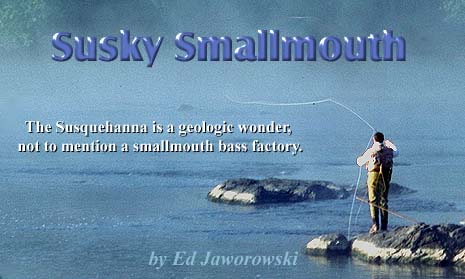 Waterways deserving "great river" status earn that designation for a variety of reasons. By any reasonable standards---size, accessibility, structure, productivity, consistency, numbers, variety and size of fish and forage,---as a fisherman's river, Pennsylvania's Susquehanna must be considered great. Waterways deserving "great river" status earn that designation for a variety of reasons. By any reasonable standards---size, accessibility, structure, productivity, consistency, numbers, variety and size of fish and forage,---as a fisherman's river, Pennsylvania's Susquehanna must be considered great.
 Rising in southern New York State, near Cooperstown, it drops into the northeast corner of Pennsylvania then, like a fickle snake, swings back into New York before re-entering Pennsylvania in a generally southwest movement. After its confluence with the West Branch near Sunbury, the river, now doubled in size, bisects the state north to south, before entering Maryland and debouching into the Chesapeake Bay. The bass introduced from the Ohio River in the 1800's have adapted well to the watershed and today millions provide diverse sport for bass anglers. The North Branch, as the river is known prior to the junction, and the West Branch, account for more than 600 miles of river, carrying more water than the Hudson or Ohio Rivers and spilling as much fresh water into the Chesapeake as all other sources combined. Rising in southern New York State, near Cooperstown, it drops into the northeast corner of Pennsylvania then, like a fickle snake, swings back into New York before re-entering Pennsylvania in a generally southwest movement. After its confluence with the West Branch near Sunbury, the river, now doubled in size, bisects the state north to south, before entering Maryland and debouching into the Chesapeake Bay. The bass introduced from the Ohio River in the 1800's have adapted well to the watershed and today millions provide diverse sport for bass anglers. The North Branch, as the river is known prior to the junction, and the West Branch, account for more than 600 miles of river, carrying more water than the Hudson or Ohio Rivers and spilling as much fresh water into the Chesapeake as all other sources combined.
 The Susquehanna is a geologic wonder. Ninety million years, and perhaps much longer, before receiving its mysterious Algonquin Indian name, its sedimentary and volcanic base was laid. While a road map indicates that all the rivers and highways of central Pennsylvania follow the southwest to northeast orientation of the mountains, the Susquehanna curiously bisects the ridges, since it predates the old Appalachians and maintained its course as they formed over the course of history. The ledges and ridges thus formed are the cause of the river's remarkable bottom structure, so perfect for smallmouth bass and the reason this is probably the most productive smallmouth fishery from the mid-Atlantic to Canada. The Susquehanna is a geologic wonder. Ninety million years, and perhaps much longer, before receiving its mysterious Algonquin Indian name, its sedimentary and volcanic base was laid. While a road map indicates that all the rivers and highways of central Pennsylvania follow the southwest to northeast orientation of the mountains, the Susquehanna curiously bisects the ridges, since it predates the old Appalachians and maintained its course as they formed over the course of history. The ledges and ridges thus formed are the cause of the river's remarkable bottom structure, so perfect for smallmouth bass and the reason this is probably the most productive smallmouth fishery from the mid-Atlantic to Canada.
|
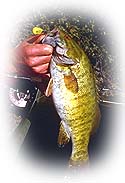
Photo by Lefty Kreh
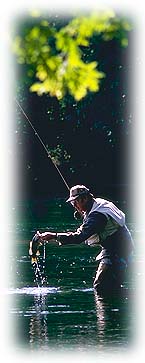
Photo by Lefty Kreh
|
 Today, the river affects the lives of everyone living along it. The economy, water supply and recreation of the area rely on it. Mink, raccoons, ducks, geese, osprey and eagles call it home, as do many area residents who have summer residences on the numerous islands in the stream, commuting by boat with the shore. In addition to fishing, at various places and times the river provides power boating, floating, picnicking and rich photographic opportunities. Today, the river affects the lives of everyone living along it. The economy, water supply and recreation of the area rely on it. Mink, raccoons, ducks, geese, osprey and eagles call it home, as do many area residents who have summer residences on the numerous islands in the stream, commuting by boat with the shore. In addition to fishing, at various places and times the river provides power boating, floating, picnicking and rich photographic opportunities.
 Whether casting from a boat or wading or float fishing, whether looking for lots of dry fly action on a summer evening, late fall lunkers or the occasional musky, the Susquehanna will meet your needs. Because of the enormous area it drains, the river generally runs high until well into June. From then through October you can find stretches to suit your sport. Whether casting from a boat or wading or float fishing, whether looking for lots of dry fly action on a summer evening, late fall lunkers or the occasional musky, the Susquehanna will meet your needs. Because of the enormous area it drains, the river generally runs high until well into June. From then through October you can find stretches to suit your sport.
 Waders or, in summer, wet wading with felt soled shoes, Stream Cleats or Korkers are the regular drill. On a river sometimes stretching a mile wide and a few feet deep a boat certainly enhances mobility. Evening dry fly action on 4-5 weight rods can readily translate to 30 fish 10-13", better than most trout fisheries, coupled with the fact that these are native fish, free risers and strong. Casting sinking flies will readily net more larger bass, over the 15" mark. Ironically, really huge fish are rare. Some of the deepest pools, especially in the series of impoundments below Middletown or in some of the deep holes of the North and West Branches will dish up the occasional Loch Ness bass. Still, in all his years, mostly fishing the Middletown-Harrisburg stretch, Bob Clouser, "the Commodore of the Susquehanna", has seen few fish over six pounds and has himself landed only seven over the five pound mark. Yet the consistency and widespread action rate highly with most anglers and the river's reputation has been built on numbers of smaller fish regularly interspersed with two to three-pounders. Waders or, in summer, wet wading with felt soled shoes, Stream Cleats or Korkers are the regular drill. On a river sometimes stretching a mile wide and a few feet deep a boat certainly enhances mobility. Evening dry fly action on 4-5 weight rods can readily translate to 30 fish 10-13", better than most trout fisheries, coupled with the fact that these are native fish, free risers and strong. Casting sinking flies will readily net more larger bass, over the 15" mark. Ironically, really huge fish are rare. Some of the deepest pools, especially in the series of impoundments below Middletown or in some of the deep holes of the North and West Branches will dish up the occasional Loch Ness bass. Still, in all his years, mostly fishing the Middletown-Harrisburg stretch, Bob Clouser, "the Commodore of the Susquehanna", has seen few fish over six pounds and has himself landed only seven over the five pound mark. Yet the consistency and widespread action rate highly with most anglers and the river's reputation has been built on numbers of smaller fish regularly interspersed with two to three-pounders.
 Open seasons in past years during spring spawning seem to have damaged the population of larger bass. On the section from Harrisburg's Dock Street Dam to Holtwood Dam, well down stream below Middletown, special regulations, 4 fish, 15" minimum (as opposed to 6 fish, 12" on the rest of the river) have had positive impact on the quality of the fishery. Clouser and the highly active and visible Susquehanna Smallmouth Alliance are currently pressuring the Pennsylvania Fish and Boat Commission to extend the trophy regulations to other parts of the river. Fly fishermen are spreading the catch and release gospel to locals who have traditionally killed limits of fish and their efforts have born much fruit, as evidenced by higher average size and numbers of bass in the trophy area. Open seasons in past years during spring spawning seem to have damaged the population of larger bass. On the section from Harrisburg's Dock Street Dam to Holtwood Dam, well down stream below Middletown, special regulations, 4 fish, 15" minimum (as opposed to 6 fish, 12" on the rest of the river) have had positive impact on the quality of the fishery. Clouser and the highly active and visible Susquehanna Smallmouth Alliance are currently pressuring the Pennsylvania Fish and Boat Commission to extend the trophy regulations to other parts of the river. Fly fishermen are spreading the catch and release gospel to locals who have traditionally killed limits of fish and their efforts have born much fruit, as evidenced by higher average size and numbers of bass in the trophy area.
 One other problem the bass face has been a seemingly cyclic, though natural, fish kill, in which many two and three year class (10-16") bass in post-spawn weakened condition, succumb to additional stresses brought on by rapid temperature and volume changes. Some years are worse than others and fishermen are trying to understand the phenomena more fully. Biologists also report that an otherwise harmless parasite may kill bass if contracted during spawning. At any rate, efforts of anglers to limit the kills of former years can only help the situation by assuring that at least some more of the larger bass are returned to the river. A seemingly heavier than normal post spawn die- off in 1993 made for a sub-par season in the lower river but most anglers expect steady improvement over the next several seasons. One other problem the bass face has been a seemingly cyclic, though natural, fish kill, in which many two and three year class (10-16") bass in post-spawn weakened condition, succumb to additional stresses brought on by rapid temperature and volume changes. Some years are worse than others and fishermen are trying to understand the phenomena more fully. Biologists also report that an otherwise harmless parasite may kill bass if contracted during spawning. At any rate, efforts of anglers to limit the kills of former years can only help the situation by assuring that at least some more of the larger bass are returned to the river. A seemingly heavier than normal post spawn die- off in 1993 made for a sub-par season in the lower river but most anglers expect steady improvement over the next several seasons.
 The Susquehanna's currents are rich in food for the bass. The wide, shallow riffles and rocks are laden with mayfly, caddis, helgramite, damselfly nymphs and crayfish and the volume of shallow water and the amount of sunlight penetration insure prolific hatches and rapid growth rates for forage and game fish. All this is enhanced by the fertile limestone waters supplied by certain tributaries. White fly (Ephoron leukon) hatches reach blizzard proportions and blot out the far shore like a dense snow storm. The first insects generally reach Middletown in late July, showing a week or more later at the Sunbury junction. The hatch lasts longer in the lower river but parts of the West and North Branches have other hatches like brown drakes and various sulphurs to supplement the shorter white fly season. The Susquehanna's currents are rich in food for the bass. The wide, shallow riffles and rocks are laden with mayfly, caddis, helgramite, damselfly nymphs and crayfish and the volume of shallow water and the amount of sunlight penetration insure prolific hatches and rapid growth rates for forage and game fish. All this is enhanced by the fertile limestone waters supplied by certain tributaries. White fly (Ephoron leukon) hatches reach blizzard proportions and blot out the far shore like a dense snow storm. The first insects generally reach Middletown in late July, showing a week or more later at the Sunbury junction. The hatch lasts longer in the lower river but parts of the West and North Branches have other hatches like brown drakes and various sulphurs to supplement the shorter white fly season.
 Juvenile bass, river shiners, black-nosed dace, madtoms and, in the warmer, lower stretches, gizzard shad also provide much forage. It is in no way strange that the most productive flies to use here are those designed by Clouser himself over a lifetime of fishing this water. The Clouser Deep Minnow has to be the first choice of most anglers. Carry them in chartreuse or chartreuse combinations, sculpin or the original baby bass pattern. Tied sparsely, Ultrahair Deep Minnows are especially productive when fishing clear, low water. His weighted Swimming Nymph, light or dark, meets most of the mayfly nymph requirements. No better crayfish imitation has been found for this river than the Clouser Crayfish, drifted slowly and steadily. To complement this assortment, I would recommend the time honored red and white hackle fly popularized in more recent years by Lefty Kreh. Juvenile bass, river shiners, black-nosed dace, madtoms and, in the warmer, lower stretches, gizzard shad also provide much forage. It is in no way strange that the most productive flies to use here are those designed by Clouser himself over a lifetime of fishing this water. The Clouser Deep Minnow has to be the first choice of most anglers. Carry them in chartreuse or chartreuse combinations, sculpin or the original baby bass pattern. Tied sparsely, Ultrahair Deep Minnows are especially productive when fishing clear, low water. His weighted Swimming Nymph, light or dark, meets most of the mayfly nymph requirements. No better crayfish imitation has been found for this river than the Clouser Crayfish, drifted slowly and steadily. To complement this assortment, I would recommend the time honored red and white hackle fly popularized in more recent years by Lefty Kreh.
|
 When flying ants are on the water, dimpling swirls indicate feeding bass. I have landed bass with their mouths completely speckled with the little black insects. Ironically, as often happens when trout feed, the smallest dimples disguise the largest fish but, unlike trout, bass will readily grab a crippled minnow or popper imitation cast nearby, seemingly taking it for a competing baitfish also gobbling ants. When flying ants are on the water, dimpling swirls indicate feeding bass. I have landed bass with their mouths completely speckled with the little black insects. Ironically, as often happens when trout feed, the smallest dimples disguise the largest fish but, unlike trout, bass will readily grab a crippled minnow or popper imitation cast nearby, seemingly taking it for a competing baitfish also gobbling ants.
 If you enjoy topwater action, by all means use bugs that are elongated and slender in profile. Long Tom poppers, Pencil Poppers and the like work best. These bass don't readily succumb to the loud plunking, wide-faced poppers and bulky deer hair offerings anglers typically throw to largemouths. Clouser's Wounded Minnow, with a deer hair head, suspends most of its body beneath the surface. When retrieved it replicates a struggling bait fish gasping for air better than any other surface lure. The only other design I now use is the Potomac River Popping Bug, a slight little thing used for years in the mid-Atlantic area and again touted highly by Lefty Kreh, who knows enough to stick with a winner. If you enjoy topwater action, by all means use bugs that are elongated and slender in profile. Long Tom poppers, Pencil Poppers and the like work best. These bass don't readily succumb to the loud plunking, wide-faced poppers and bulky deer hair offerings anglers typically throw to largemouths. Clouser's Wounded Minnow, with a deer hair head, suspends most of its body beneath the surface. When retrieved it replicates a struggling bait fish gasping for air better than any other surface lure. The only other design I now use is the Potomac River Popping Bug, a slight little thing used for years in the mid-Atlantic area and again touted highly by Lefty Kreh, who knows enough to stick with a winner.
 Use whatever line/rod weight is comfortable for you but note that the most experienced flycasters on the river will cite a 7 or 8-weight as "standard". In the downstream stretches, where most of the fishing is done by boat and in the middle areas, from Marysville north to around Liverpool, which contain most of the better wadeable stretches, floating weight-forwards are used almost exclusively. Mike O'Brien, who guides on the upper stretches and especially on the West Branch says sink tips and sinking lines are important alternatives for his anglers. The river in these parts is narrower with long deep pools and floating lines often may not get your flies deep enough. Use whatever line/rod weight is comfortable for you but note that the most experienced flycasters on the river will cite a 7 or 8-weight as "standard". In the downstream stretches, where most of the fishing is done by boat and in the middle areas, from Marysville north to around Liverpool, which contain most of the better wadeable stretches, floating weight-forwards are used almost exclusively. Mike O'Brien, who guides on the upper stretches and especially on the West Branch says sink tips and sinking lines are important alternatives for his anglers. The river in these parts is narrower with long deep pools and floating lines often may not get your flies deep enough.
 If you plan to explore the water without a guide, look for gravel bars and grass beds in midstream and especially rock ledges. Smallmouth gravitate to all these spots. On the upper main river and the West and North Branches "wood", more reminiscent of largemouth habitat, provides good cover. Fish the shade side of trees uprooted by floods, large branches and deadfalls in the water. O'Brien rates these spots highly. Another key spot to search, though often missed by anglers, is the cushion or pillow of slack water in front of submerged boulders. Large bass particularly seek these holding spots but whether there is one there depends on the shape of the rock, which you can't always determine from the surface. Those which generate a lot of turbulence in front will not attract bigger bass. The only way to be sure is to hit each one as you drift by or can reach by wading. If you plan to explore the water without a guide, look for gravel bars and grass beds in midstream and especially rock ledges. Smallmouth gravitate to all these spots. On the upper main river and the West and North Branches "wood", more reminiscent of largemouth habitat, provides good cover. Fish the shade side of trees uprooted by floods, large branches and deadfalls in the water. O'Brien rates these spots highly. Another key spot to search, though often missed by anglers, is the cushion or pillow of slack water in front of submerged boulders. Large bass particularly seek these holding spots but whether there is one there depends on the shape of the rock, which you can't always determine from the surface. Those which generate a lot of turbulence in front will not attract bigger bass. The only way to be sure is to hit each one as you drift by or can reach by wading.
 The standard smallmouth retrieve, which should be your starting point, is a long steady draw, 2-3', with the line hand. This attracts fish, covers a lot of water and then allows the weighted streamer to sink between strips. Smallmouth most often hit when a fly is falling and you should anticipate strikes at this point. Watch your fly; often you will see it disappear without actually seeing the bass, or see a swirl which indicates a take before the line telegraphs it. The standard smallmouth retrieve, which should be your starting point, is a long steady draw, 2-3', with the line hand. This attracts fish, covers a lot of water and then allows the weighted streamer to sink between strips. Smallmouth most often hit when a fly is falling and you should anticipate strikes at this point. Watch your fly; often you will see it disappear without actually seeing the bass, or see a swirl which indicates a take before the line telegraphs it.
 Both O'Brien and Clouser put a lot of stock in sun angles and glare. Concentrate on spots that offer shadow protection for the bass. Since the river has so many turns and twists in some sections, islands, ledges and boulders in others, you can always find such spots. Edges, where clear and cloudy water mingle, such as down stream of tributaries entering the main stream provide a similar scenario. The fish will lay in the more clouded water and race to snatch a flashy minnow from the clearer. Fishing the western shore in late after noon will put you into shadow while the mid river and eastern shore are still subjected to harsh light. At night fish will crowd close to shore, in amazingly skinny water. The magnified sounds of splashing and feeding fish make for exciting sport, just make certain you are familiar with the area in daylight before attempting any nocturnal forays. Fish large, dark flies slowly. They move surface water and the bass here are generally surface oriented. Both O'Brien and Clouser put a lot of stock in sun angles and glare. Concentrate on spots that offer shadow protection for the bass. Since the river has so many turns and twists in some sections, islands, ledges and boulders in others, you can always find such spots. Edges, where clear and cloudy water mingle, such as down stream of tributaries entering the main stream provide a similar scenario. The fish will lay in the more clouded water and race to snatch a flashy minnow from the clearer. Fishing the western shore in late after noon will put you into shadow while the mid river and eastern shore are still subjected to harsh light. At night fish will crowd close to shore, in amazingly skinny water. The magnified sounds of splashing and feeding fish make for exciting sport, just make certain you are familiar with the area in daylight before attempting any nocturnal forays. Fish large, dark flies slowly. They move surface water and the bass here are generally surface oriented.
 Always carry rain gear here. The Susquehanna watershed dishes up some of the most diverse weather in the region, particularly in summer. Huge thunderheads will roll in from the west and sweep right down the valley, bringing with them an obvious wall of water and soaking the area with brief but torrential rains. Get off the water when they appear. Immediately after such storms the bass often turn on, either because of the feeding prompted by the influx of food washed into the river or stimulated by the sudden oxygenation of the water caused by the surface agitation. Fortunately, brief thunderstorms don't adversely affect this broad river, though local changes can hurt or help your fishing. The first raise of cloudy water from an upstream rain will cause fish to lose caution and provide anglers with remarkable action. Two summers ago, while guided by Bob Clouser, Tom Gilmore and I hit just such conditions. After deliberating for a long time whether or not to cancel, we decided to go. We caught more fish between 14 and 18+" than I had caught in the previous ten years combined. One of the best situations is an overcast, calm day, with no wind and even a slight drizzle. This eliminates shadows, appears to make the fish less spooky and casting a breeze. Always carry rain gear here. The Susquehanna watershed dishes up some of the most diverse weather in the region, particularly in summer. Huge thunderheads will roll in from the west and sweep right down the valley, bringing with them an obvious wall of water and soaking the area with brief but torrential rains. Get off the water when they appear. Immediately after such storms the bass often turn on, either because of the feeding prompted by the influx of food washed into the river or stimulated by the sudden oxygenation of the water caused by the surface agitation. Fortunately, brief thunderstorms don't adversely affect this broad river, though local changes can hurt or help your fishing. The first raise of cloudy water from an upstream rain will cause fish to lose caution and provide anglers with remarkable action. Two summers ago, while guided by Bob Clouser, Tom Gilmore and I hit just such conditions. After deliberating for a long time whether or not to cancel, we decided to go. We caught more fish between 14 and 18+" than I had caught in the previous ten years combined. One of the best situations is an overcast, calm day, with no wind and even a slight drizzle. This eliminates shadows, appears to make the fish less spooky and casting a breeze.
|
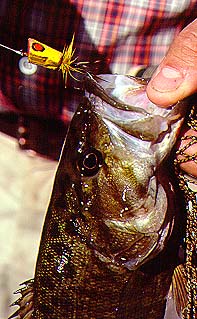
Photo by Joe Reynolds
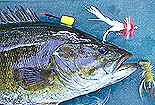
Photo by Lefty Kreh
|
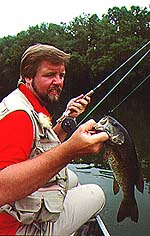
Photo by Joe Reynolds
|
 Don't get that impression that because you can readily catch smaller bass on a variety of surface and subsurface flies they are easy prey or not intelligent fish. In a river like the Susquehanna they are numerous and so, competitive. Larger bass are another story entirely, shy, wily, hesitant and especially territorial. If you consistently pull small fish from an area, the odds are that you will continue to do so. For bigger game, change location first, then technique or fly. Also, fall is the time to concentrate on large fish. They will feed heavily with the approach of cold weather, when the water temperature declines through the 50's. Fishing large flies, slowly and deep, will present you with the best opportunities for the bigger fish. Even during the warmer months, large flies attract a lot more big smallmouth, which feed more sporadically, but more heavily, than the little fellows. September and October are probably the best overall months. Don't get that impression that because you can readily catch smaller bass on a variety of surface and subsurface flies they are easy prey or not intelligent fish. In a river like the Susquehanna they are numerous and so, competitive. Larger bass are another story entirely, shy, wily, hesitant and especially territorial. If you consistently pull small fish from an area, the odds are that you will continue to do so. For bigger game, change location first, then technique or fly. Also, fall is the time to concentrate on large fish. They will feed heavily with the approach of cold weather, when the water temperature declines through the 50's. Fishing large flies, slowly and deep, will present you with the best opportunities for the bigger fish. Even during the warmer months, large flies attract a lot more big smallmouth, which feed more sporadically, but more heavily, than the little fellows. September and October are probably the best overall months.
 Although I have concentrated on the smallmouth bass, the Susquehanna has other games to offer. Panfish---rock bass, crappie, redbreast and pumpkinseed sunfish---concentrate in the slower areas. Below the four impoundment dams south of Middletown, from York Haven to Conowingo, and in the deeper, moving holes of the upper branches and around the Fabri-dam at Sunbury, you will find walleyes, though too few fly fishermen angle for them. Similarly, muskies are only occasionally caught in the middle section noted for its bass, but they are regularly taken in the West Branch around Williamsport and in the upper reaches of the North Branch. Mike O'Brien has clients who pursue carp on a regular basis. They either sight cast to the fish with sinking nymphs or anchor, blind cast and slowly retrieve across shallow bottoms where the fish are seen to feed. A 10-pound carp will make your drag scream. Although I have concentrated on the smallmouth bass, the Susquehanna has other games to offer. Panfish---rock bass, crappie, redbreast and pumpkinseed sunfish---concentrate in the slower areas. Below the four impoundment dams south of Middletown, from York Haven to Conowingo, and in the deeper, moving holes of the upper branches and around the Fabri-dam at Sunbury, you will find walleyes, though too few fly fishermen angle for them. Similarly, muskies are only occasionally caught in the middle section noted for its bass, but they are regularly taken in the West Branch around Williamsport and in the upper reaches of the North Branch. Mike O'Brien has clients who pursue carp on a regular basis. They either sight cast to the fish with sinking nymphs or anchor, blind cast and slowly retrieve across shallow bottoms where the fish are seen to feed. A 10-pound carp will make your drag scream.
 Channel catfish may be the most intriguing of all. While they often hit offerings intended for smallmouth, they are a prime target at dusk and after dark, particularly during the white fly hatch. Catfish are more spooky than most trout. A noisy approach, splashy cast or drag will assure refusals. It's also difficult to locate sippers and gulpers in the failing light or after dark when they take up position in slow currents and gently suck spinners from the surface. Use a fixed length of line, don't move around much and strike at any suspicious noise or movement. In this brand of instinct fishing, you will strike ten times before you hook up once but the fish may run over five pounds. The game is eerie and spooky but if you can manage to outwit one or two a night, which is a good average, you won't believe the commotion they can put up, as well as their strength and stamina. Channel catfish may be the most intriguing of all. While they often hit offerings intended for smallmouth, they are a prime target at dusk and after dark, particularly during the white fly hatch. Catfish are more spooky than most trout. A noisy approach, splashy cast or drag will assure refusals. It's also difficult to locate sippers and gulpers in the failing light or after dark when they take up position in slow currents and gently suck spinners from the surface. Use a fixed length of line, don't move around much and strike at any suspicious noise or movement. In this brand of instinct fishing, you will strike ten times before you hook up once but the fish may run over five pounds. The game is eerie and spooky but if you can manage to outwit one or two a night, which is a good average, you won't believe the commotion they can put up, as well as their strength and stamina.
 You can get daily river level reports at Harrisburg by dialing 800-362-0335. When the river measures 4.0 feet at Harrisburg, the height is ideal for boat fishing. At 3.2 it is wadeable, better at 3.0. Above 5-6'rocks begin to get covered and you lose fishing spots, as well as boat control. But the levels are relative and in different stretches of the river, the numbers have different significance. For example, at Williamsport, on the West Branch, 3.0 makes for difficult fishing, due to the faster flow. Check with tackle shops or tune to local weather band radio stations for updates if you plan to fish the river. As fishermen predict fishing conditions, locals residents predict flooded yards, wet basements and heavier flood damage accurately, based on river levels. You can get daily river level reports at Harrisburg by dialing 800-362-0335. When the river measures 4.0 feet at Harrisburg, the height is ideal for boat fishing. At 3.2 it is wadeable, better at 3.0. Above 5-6'rocks begin to get covered and you lose fishing spots, as well as boat control. But the levels are relative and in different stretches of the river, the numbers have different significance. For example, at Williamsport, on the West Branch, 3.0 makes for difficult fishing, due to the faster flow. Check with tackle shops or tune to local weather band radio stations for updates if you plan to fish the river. As fishermen predict fishing conditions, locals residents predict flooded yards, wet basements and heavier flood damage accurately, based on river levels.
|
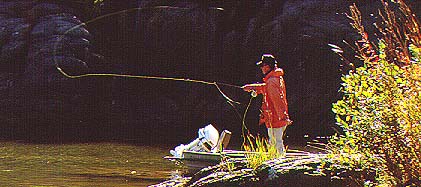
Photo by Joe Reynolds
|
 Although the two branches of the Susquehanna afford hundreds of miles of opportunity that too few fly anglers tap into, the middle portion, from Sunbury to Middletown just south of Harrisburg, the state capital is the most popular. Access to the region is easy. The east- west Pennsylvania Turnpike crosses the river just below Harrisburg. Interstate 80 parallels the Turnpike 60-70 miles to the north, giving access to the upper part of this main stem, as well as the West Branch and lower portions of the North Branch. For most of the distance between these highways, Routes 15 and 147, running north-south and paralleling the west and east sides of the river respectively, afford access. Portions of the West Branch still suffer from mine seepages but the pollution has been steadily diminishing over the past two decades and the fishing improving. The section of the North Branch around Scranton and Wilkes-Barre still suffers from a variety of pollution sources but above and below there are many miles of great sport. Major tributaries between Harrisburg and Sunbury include the Swatara at Middletown, Conodoguinet at Harrisburg on the west side, Sherman Creek at Duncannon and the Juniata at Clark's Ferry. This last is a famous bass stream in its own right and all serve as spawning tributaries and can be fished for some distance from their mouths if the main river is unfishable. Although the two branches of the Susquehanna afford hundreds of miles of opportunity that too few fly anglers tap into, the middle portion, from Sunbury to Middletown just south of Harrisburg, the state capital is the most popular. Access to the region is easy. The east- west Pennsylvania Turnpike crosses the river just below Harrisburg. Interstate 80 parallels the Turnpike 60-70 miles to the north, giving access to the upper part of this main stem, as well as the West Branch and lower portions of the North Branch. For most of the distance between these highways, Routes 15 and 147, running north-south and paralleling the west and east sides of the river respectively, afford access. Portions of the West Branch still suffer from mine seepages but the pollution has been steadily diminishing over the past two decades and the fishing improving. The section of the North Branch around Scranton and Wilkes-Barre still suffers from a variety of pollution sources but above and below there are many miles of great sport. Major tributaries between Harrisburg and Sunbury include the Swatara at Middletown, Conodoguinet at Harrisburg on the west side, Sherman Creek at Duncannon and the Juniata at Clark's Ferry. This last is a famous bass stream in its own right and all serve as spawning tributaries and can be fished for some distance from their mouths if the main river is unfishable.
 The preferred craft for this river is a flat bottom jon boat of 14' minimum length with a 48" bottom beam---longer and wider are better. For two anglers, 10-15hp is ideal, but due to the ubiquitous rocks, jet outboards are becoming more popular, as they have no lower unit extending into the water. Many anglers fishing with conventional outboards use prop guards, or "pitchforks", to protect the lower unit, and then run slowly in shallow areas. A spare anchor is good insurance as rugged river rocks take their toll. Experienced anglers also rely on push poles to get into shallow pockets quietly. The preferred craft for this river is a flat bottom jon boat of 14' minimum length with a 48" bottom beam---longer and wider are better. For two anglers, 10-15hp is ideal, but due to the ubiquitous rocks, jet outboards are becoming more popular, as they have no lower unit extending into the water. Many anglers fishing with conventional outboards use prop guards, or "pitchforks", to protect the lower unit, and then run slowly in shallow areas. A spare anchor is good insurance as rugged river rocks take their toll. Experienced anglers also rely on push poles to get into shallow pockets quietly.
 While the best way to fish the river is to use a boat and fish a limited section or wade, floating is an alternative. However, shallow riffles, rocks, islands and lack of consistent, obvious and deep main channels can cause problems. You can take the wrong channel and wind up having to carry the craft around and over obstacles. Still, if you are willing to do some advance scouting and/or put up with an occasional inconvenience, you can arrange a number of pleasant, day-long canoe floats. By planning to float from/to launch areas or campgrounds three to seven miles apart, you can cover a lot of productive water. There are few dams along this portion of the river. While the best way to fish the river is to use a boat and fish a limited section or wade, floating is an alternative. However, shallow riffles, rocks, islands and lack of consistent, obvious and deep main channels can cause problems. You can take the wrong channel and wind up having to carry the craft around and over obstacles. Still, if you are willing to do some advance scouting and/or put up with an occasional inconvenience, you can arrange a number of pleasant, day-long canoe floats. By planning to float from/to launch areas or campgrounds three to seven miles apart, you can cover a lot of productive water. There are few dams along this portion of the river.
 A few of the boat launch areas, which also afford wading access, are located on the east side at Middletown, Harrisburg, Fort Hunter, Halifax, Millersburg and Sunbury; on the west side, at Goldsboro, Enola, New Buffalo, Montgomery Ferry, Sweigart Island (near Liverpool), McKees Half Falls, Hoover Island (near Selinsgrove) and Shamokin Dam. In addition to these and other landings, occasional roadside picnic areas or campsites are available. A few of the boat launch areas, which also afford wading access, are located on the east side at Middletown, Harrisburg, Fort Hunter, Halifax, Millersburg and Sunbury; on the west side, at Goldsboro, Enola, New Buffalo, Montgomery Ferry, Sweigart Island (near Liverpool), McKees Half Falls, Hoover Island (near Selinsgrove) and Shamokin Dam. In addition to these and other landings, occasional roadside picnic areas or campsites are available.
 One of the river's most remarkable features is the world's largest inflatable rubber dam at Sunbury. During the summer and early fall, huge rubber bags stretching the width of the river are inflated to form a 3000 acre holding pool which backs up water for miles into the North and West Branches. Its function is strictly for the recreational use of boaters, water skiers and fishermen, although, needless to say, the crowds this engineering wonder draws seem at odds with the quiet sport fly fishermen seek. Most pressure by wading anglers occurs in the Marysville section, just downstream from Duncannon on the west side. Though heavily fished, this stretch turns up lots of fish 10-14". Scout the next 20 miles upstream and you can find as good or better fishing. Wading is ideal and safe when the river at Harrisburg drops to three feet. One of the river's most remarkable features is the world's largest inflatable rubber dam at Sunbury. During the summer and early fall, huge rubber bags stretching the width of the river are inflated to form a 3000 acre holding pool which backs up water for miles into the North and West Branches. Its function is strictly for the recreational use of boaters, water skiers and fishermen, although, needless to say, the crowds this engineering wonder draws seem at odds with the quiet sport fly fishermen seek. Most pressure by wading anglers occurs in the Marysville section, just downstream from Duncannon on the west side. Though heavily fished, this stretch turns up lots of fish 10-14". Scout the next 20 miles upstream and you can find as good or better fishing. Wading is ideal and safe when the river at Harrisburg drops to three feet.
 If you have never fly fished for smallmouth bass or are eager to sample some of the best, give the Susquehanna a try. Do a little homework; select a time and a stretch convenient to you. Go it on your own or book a guide. Either way, it's hard to be disappointed. If you have never fly fished for smallmouth bass or are eager to sample some of the best, give the Susquehanna a try. Do a little homework; select a time and a stretch convenient to you. Go it on your own or book a guide. Either way, it's hard to be disappointed.
|
|
